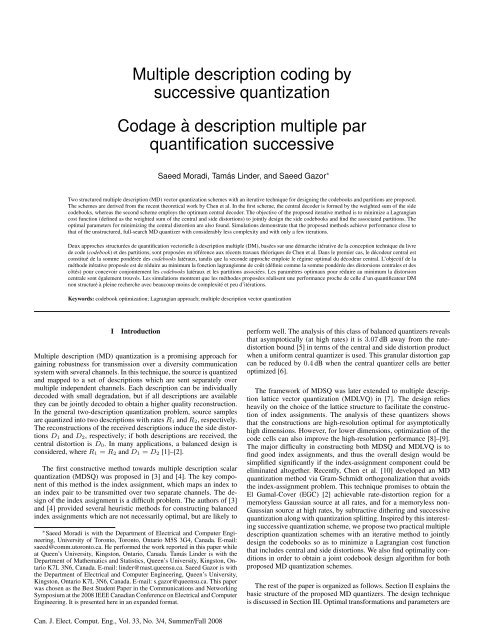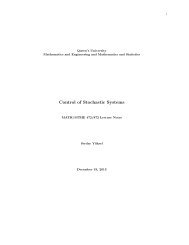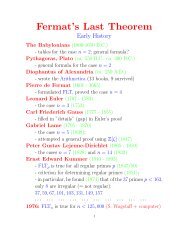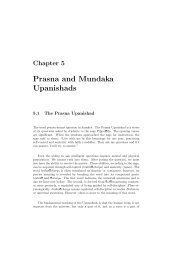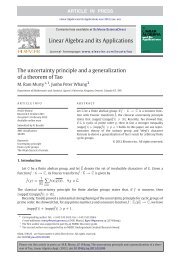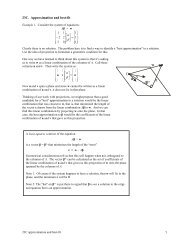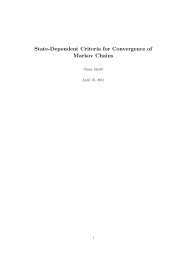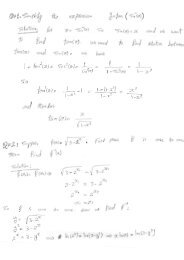Multiple description coding by successive quantization Codage `a ...
Multiple description coding by successive quantization Codage `a ...
Multiple description coding by successive quantization Codage `a ...
Create successful ePaper yourself
Turn your PDF publications into a flip-book with our unique Google optimized e-Paper software.
<strong>Multiple</strong> <strong>description</strong> <strong>coding</strong> <strong>by</strong><br />
<strong>successive</strong> <strong>quantization</strong><br />
<strong>Codage</strong> à <strong>description</strong> multiple par<br />
quantification <strong>successive</strong><br />
Saeed Moradi, Tamás Linder, and Saeed Gazor ∗<br />
Two structured multiple <strong>description</strong> (MD) vector <strong>quantization</strong> schemes with an iterative technique for designing the codebooks and partitions are proposed.<br />
The schemes are derived from the recent theoretical work <strong>by</strong> Chen et al. In the first scheme, the central decoder is formed <strong>by</strong> the weighted sum of the side<br />
codebooks, whereas the second scheme employs the optimum central decoder. The objective of the proposed iterative method is to minimize a Lagrangian<br />
cost function (defined as the weighted sum of the central and side distortions) to jointly design the side codebooks and find the associated partitions. The<br />
optimal parameters for minimizing the central distortion are also found. Simulations demonstrate that the proposed methods achieve performance close to<br />
that of the unstructured, full-search MD quantizer with considerably less complexity and with only a few iterations.<br />
Deux approches structurées de quantification vectorielle à <strong>description</strong> multiple (DM), basées sur une démarche itérative de la conception technique du livre<br />
de code (codebook) et des partitions, sont proposées en référence aux récents travaux théoriques de Chen et al. Dans le premier cas, le décodeur central est<br />
constitué de la somme pondérée des codebooks latéraux, tandis que la seconde approche emploie le régime optimal du décodeur central. L’objectif de la<br />
méthode itérative proposée est de réduire au minimum la fonction lagrangienne de coût (définie comme la somme pondérée des distorsions centrales et des<br />
côtés) pour concevoir conjointement les codebooks latéraux et les partitions associées. Les paramètres optimaux pour réduire au minimum la distorsion<br />
centrale sont également trouvés. Les simulations montrent que les méthodes proposées réalisent une performance proche de celle d’un quantificateur DM<br />
non structuré à pleine recherche avec beaucoup moins de complexité et peu d’itérations.<br />
Keywords: codebook optimization; Lagrangian approach; multiple <strong>description</strong> vector <strong>quantization</strong><br />
I Introduction<br />
<strong>Multiple</strong> <strong>description</strong> (MD) <strong>quantization</strong> is a promising approach for<br />
gaining robustness for transmission over a diversity communication<br />
system with several channels. In this technique, the source is quantized<br />
and mapped to a set of <strong>description</strong>s which are sent separately over<br />
multiple independent channels. Each <strong>description</strong> can be individually<br />
decoded with small degradation, but if all <strong>description</strong>s are available<br />
they can be jointly decoded to obtain a higher quality reconstruction.<br />
In the general two-<strong>description</strong> <strong>quantization</strong> problem, source samples<br />
are quantized into two <strong>description</strong>s with rates R1 and R2, respectively.<br />
The reconstructions of the received <strong>description</strong>s induce the side distortions<br />
D1 and D2, respectively; if both <strong>description</strong>s are received, the<br />
central distortion is D0. In many applications, a balanced design is<br />
considered, where R1 = R2 and D1 = D2 [1]–[2].<br />
The first constructive method towards multiple <strong>description</strong> scalar<br />
<strong>quantization</strong> (MDSQ) was proposed in [3] and [4]. The key component<br />
of this method is the index assignment, which maps an index to<br />
an index pair to be transmitted over two separate channels. The design<br />
of the index assignment is a difficult problem. The authors of [3]<br />
and [4] provided several heuristic methods for constructing balanced<br />
index assignments which are not necessarily optimal, but are likely to<br />
∗ Saeed Moradi is with the Department of Electrical and Computer Engineering,<br />
University of Toronto, Toronto, Ontario M5S 3G4, Canada. E-mail:<br />
saeed@comm.utoronto.ca. He performed the work reported in this paper while<br />
at Queen’s University, Kingston, Ontario, Canada. Tamás Linder is with the<br />
Department of Mathematics and Statistics, Queen’s University, Kingston, Ontario<br />
K7L 3N6, Canada. E-mail: linder@mast.queensu.ca. Saeed Gazor is with<br />
the Department of Electrical and Computer Engineering, Queen’s University,<br />
Kingston, Ontario K7L 3N6, Canada. E-mail: s.gazor@queensu.ca. This paper<br />
was chosen as the Best Student Paper in the Communications and Networking<br />
Symposium at the 2008 IEEE Canadian Conference on Electrical and Computer<br />
Engineering. It is presented here in an expanded format.<br />
Can. J. Elect. Comput. Eng., Vol. 33, No. 3/4, Summer/Fall 2008<br />
perform well. The analysis of this class of balanced quantizers reveals<br />
that asymptotically (at high rates) it is 3.07 dB away from the ratedistortion<br />
bound [5] in terms of the central and side distortion product<br />
when a uniform central quantizer is used. This granular distortion gap<br />
can be reduced <strong>by</strong> 0.4 dB when the central quantizer cells are better<br />
optimized [6].<br />
The framework of MDSQ was later extended to multiple <strong>description</strong><br />
lattice vector <strong>quantization</strong> (MDLVQ) in [7]. The design relies<br />
heavily on the choice of the lattice structure to facilitate the construction<br />
of index assignments. The analysis of these quantizers shows<br />
that the constructions are high-resolution optimal for asymptotically<br />
high dimensions. However, for lower dimensions, optimization of the<br />
code cells can also improve the high-resolution performance [8]–[9].<br />
The major difficulty in constructing both MDSQ and MDLVQ is to<br />
find good index assignments, and thus the overall design would be<br />
simplified significantly if the index-assignment component could be<br />
eliminated altogether. Recently, Chen et al. [10] developed an MD<br />
<strong>quantization</strong> method via Gram-Schmidt orthogonalization that avoids<br />
the index-assignment problem. This technique promises to obtain the<br />
El Gamal-Cover (EGC) [2] achievable rate-distortion region for a<br />
memoryless Gaussian source at all rates, and for a memoryless non-<br />
Gaussian source at high rates, <strong>by</strong> subtractive dithering and <strong>successive</strong><br />
<strong>quantization</strong> along with <strong>quantization</strong> splitting. Inspired <strong>by</strong> this interesting<br />
<strong>successive</strong> <strong>quantization</strong> scheme, we propose two practical multiple<br />
<strong>description</strong> <strong>quantization</strong> schemes with an iterative method to jointly<br />
design the codebooks so as to minimize a Lagrangian cost function<br />
that includes central and side distortions. We also find optimality conditions<br />
in order to obtain a joint codebook design algorithm for both<br />
proposed MD <strong>quantization</strong> schemes.<br />
The rest of the paper is organized as follows. Section II explains the<br />
basic structure of the proposed MD quantizers. The design technique<br />
is discussed in Section III. Optimal transformations and parameters are
134 CAN. J. ELECT. COMPUT. ENG., VOL. 33, NO. 3/4, SUMMER/FALL 2008<br />
Figure 1: MDVQ with two channels: (a) MDVQ-WSC scheme in which the central codebook<br />
is generated as the weighted sum of the two side codebooks; (b) MDVQ-OC scheme<br />
using the optimum central decoder.<br />
found in Section IV. Section V provides the complexity comparison.<br />
Simulation results are presented in Section VI. Finally, Section VII<br />
concludes the paper.<br />
II Proposed MD <strong>quantization</strong> schemes<br />
In [10] a structured MD entropy-constrained vector <strong>quantization</strong> (MD-<br />
ECVQ) scheme was proposed and shown to be asymptotically optimal<br />
within the limit of large block lengths. Our goal is to develop a<br />
method to iteratively optimize the structured <strong>quantization</strong> scheme proposed<br />
in [10] for practical quantizer dimensions, an issue that was not<br />
studied in [10]. The structure of the proposed MDVQ scheme is depicted<br />
in Fig. 1. The structures shown are similar to that of the asymptotically<br />
optimal MD-ECVQ scheme of [10], except that the dithered<br />
lattice quantizers are replaced <strong>by</strong> ordinary nearest-neighbour vector<br />
quantizers. These multiple <strong>description</strong> systems produce two different<br />
lossy <strong>description</strong>s of the source with quantizers Q (1) and Q (2) . The<br />
input is a k-dimensional vector X. The quantizer Q (1) uses a codebook<br />
Y = {y1, y2, . . . , yN }, and the quantizer Q (2) uses a codebook<br />
Z = {z1, z2, . . . , zM }. Both Q (1) and Q (2) are nearest-neighbour<br />
quantizers. Since we are interested in the balanced case where channels<br />
operate at equal rates, we take M to be equal to N, i.e., M = N.<br />
The encoders Q (1)<br />
e and Q (2)<br />
e generate indices i and j, which correspond<br />
to code vectors yi and zj respectively. In other words, if the<br />
input vector x lies in the central partition region Wij, then indices i<br />
and j are generated. This input will be mapped to code vectors yi and<br />
zj at the first and second side decoder respectively. As a result, we can<br />
introduce new partitions of the input, each associated with a particular<br />
side quantizer as follows:<br />
Ri = SM m=1Wim, Sj = SN n=1Wnj, (1)<br />
where Ri is the set of all input vectors mapped to the first side quantizer<br />
index i, and Sj is similarly the set of all input vectors mapped<br />
to the second side quantizer index j. The input to the second quan-<br />
tizer, Q (2) , is produced <strong>by</strong> linear transformation (scaling) of the input<br />
vector X and Q (1) (X) (or equivalently Q (1)<br />
d (Q(1)<br />
e (X))) with scalars<br />
a1 and a2. The indices i and j are transmitted over the separate channels<br />
provided <strong>by</strong> the diversity system. If only one of the indices is<br />
received, the corresponding side decoder is used to reconstruct the<br />
source vector. However, if both indices are received, the central decoder<br />
of the MDVQ with weighted sum central (MDVQ-WSC) decoder<br />
scheme reconstructs the source using linear transformations of<br />
the received decoded <strong>description</strong>s with transformation matrices β1 and<br />
β2. The optimized transformations a1, a2, β1, and β2 are discussed in<br />
Section IV. After the encoder and decoder of the quantizers are designed,<br />
the linear transformation can be replaced <strong>by</strong> the optimal MD<br />
decoder Q (0) . If both indices are received <strong>by</strong> the MDVQ with optimum<br />
central (MDVQ-OC) decoder system, the decoder uses the optimum<br />
central codebook to reconstruct the source. This will improve the<br />
central decoder’s performance at the cost of increased complexity.<br />
III Design method<br />
In this section, we present an iterative algorithm for designing the<br />
quantizers. The algorithm iteratively minimizes a Lagrangian cost<br />
function which includes constraints on the side distortions. This procedure<br />
leads to a possibly sub-optimal design of quantizers under the<br />
given constraints. The Lagrangian cost function is given <strong>by</strong><br />
L = λ0D0 + λ1D1 + λ2D2<br />
h<br />
= λ0E � X − β1Q (1) (X) − β2Q (2) (X) � 2i<br />
h<br />
+ λ1E � X − Q (1) (X) � 2<br />
i h<br />
+ λ2E � X − Q (2) (X) � 2<br />
i<br />
, (2)<br />
where λ0, λ1, and λ2 are positive constants. The optimality conditions<br />
for minimizing the Lagrangian function are derived in the next section.<br />
III.A Optimality conditions for the MDVQ-WSC system<br />
For a fixed second side quantizer Q (2) and for a given first side quantizer<br />
Q (1) partition of the input space, the Q (1) codebook is optimal<br />
if, for each i, yi minimizes the conditional Lagrangian function given<br />
the region Ri. As a result, the optimal yi is the y that minimizes the<br />
conditional Lagrangian function<br />
h<br />
L1,i = λ0E � X − β1y − β2Q (2) (a1X + a2y) � 2 i<br />
| X ∈ Ri<br />
+ λ1E ˆ � X − y � 2 ˜<br />
| X ∈ Ri . (3)<br />
Since y is an argument of the <strong>quantization</strong> function Q (2) , an explicit<br />
minimization solution of the Lagrangian function turns out to be intractable.<br />
However, if we ease the notion of optimality as in [11] and<br />
fix Q (2) , then the above Lagrangian function becomes quadratic in y<br />
and can be minimized with an iterative technique which takes the encoder<br />
of the second quantizer to be fixed while optimizing the decoder<br />
of the first quantizer. Thus, we seek y to minimize the Lagrangian<br />
function<br />
L1,i = λ0E ˆ � X − β1y − β2U � 2 ˜<br />
| X ∈ Ri<br />
+ λ1E ˆ � X − y � 2 ˜<br />
| X ∈ Ri , (4)<br />
where U = Q (2) (a1X+a2yi). Taking the gradient of (4) with respect<br />
to y yields<br />
∂L1,i<br />
∂y = −2λ0βT 1 E [(X − β1y − β2U) | X ∈ Ri]<br />
− 2λ1E [(X − y) | X ∈ Ri] . (5)<br />
The optimal y can then be found <strong>by</strong> solving the equation<br />
“<br />
λ0β T ”<br />
1 β1 + λ1I y = λ0β T 1 E [(X − β2U) | X ∈ Ri]<br />
+ λ1E [X | X ∈ Ri] , (6)
MORADI / LINDER / GAZOR: MULTIPLE DESCRIPTION CODING BY SUCCESSIVE QUANTIZATION 135<br />
where I is the identity matrix. The solution of the above equation is<br />
given <strong>by</strong><br />
y ∗ “<br />
i = λ0β T ” −1 “<br />
1 β1 + λ1I λ0β T h“<br />
1 E X − β2Q (2) ”<br />
(a1X + a2yi)<br />
| X ∈ Ri]+λ1E [X | X ∈ Ri]) . (7)<br />
For a fixed Q (1) and for a given Q (2) partition of the input space, the<br />
Q (2) codebook is optimal if, for each j, zj minimizes the conditional<br />
Lagrangian function in region Sj. Then, the optimal zj is the z that<br />
minimizes the conditional Lagrangian function<br />
h<br />
L2,j = λ0E � X − β1Q (1) (X) − β2z � 2 i<br />
| X ∈ Sj<br />
+ λ2E ˆ � X − z � 2 ˜<br />
| X ∈ Sj . (8)<br />
Similarly, we seek z to minimize the Lagrangian function<br />
L2,j = λ0E ˆ � U(X) − β2z � 2 ˜<br />
| X ∈ Sj<br />
+ λ2E ˆ � X − z � 2 ˜<br />
| X ∈ Sj , (9)<br />
where U(X) = X − β1Q (1) (X). Taking the gradient of (9) with<br />
respect to z yields<br />
∂L2,j<br />
∂z = −2λ0βT 2 E [(U(X) − β2z) | X ∈ Sj]<br />
− 2λ2E [(X − z) | X ∈ Xj] . (10)<br />
The optimal z can then be found <strong>by</strong> solving the equation<br />
“<br />
λ0β T ”<br />
2 β2 + λ2I z = λ0β T 2 E [U(X) | X ∈ Sj]<br />
+ λ2E [X | X ∈ Sj] . (11)<br />
The solution of the above equation is given <strong>by</strong><br />
z ∗ “<br />
j = λ0β T ” −1<br />
2 β2 + λ2I<br />
“<br />
× λ0β T 2 E[X − β1Q (1) ”<br />
(X) | X ∈ Sj]+λ2E[X | X ∈ Sj] . (12)<br />
Equations (7) and (12) provide the design conditions required to<br />
improve the codebooks of the side quantizers in an iterative procedure<br />
in order to minimize the Lagrangian cost function.<br />
III.B Optimality conditions for the MDVQ-OC system<br />
The derivation of optimality conditions for the MDVQ-OC system is<br />
almost identical to the argument in the previous section. Since this<br />
scheme uses the optimum central decoder, the first terms of L1,i in (4)<br />
vanish, and the optimal y ∗ and z ∗ are found to be<br />
y ∗ i = E [X | X ∈ Ri] , (13)<br />
z ∗ j = E [X | X ∈ Sj] . (14)<br />
III.C Design algorithm<br />
This section introduces an iterative technique to enhance the codebooks<br />
and, consequently, minimize the Lagrangian cost function as the<br />
optimization criterion. The iterative algorithm is similar to the Generalized<br />
Lloyd Algorithm (GLA) [12]. However, unlike the GLA, it does<br />
not necessarily produce a non-increasing sequence of Lagrangian values.<br />
Suppose we have a training set T that includes L training vectors<br />
xl, l =1, 2, . . . , L. We use the superscript (n) to indicate variables<br />
in the n-th iteration step. Suppose we have initial codebooks Y (0)<br />
and Z (0) , obtained <strong>by</strong> traditional single-<strong>description</strong> design, for the first<br />
and second quantizer respectively. Let Ln denote the Lagrangian value<br />
computed in the n-th iteration step. The iterative algorithm steps are<br />
as follows:<br />
1. Encode and partition training set: Encode each vector in the<br />
training set with the current codebooks. Let i(k) and j(k) denote<br />
the indices generated in en<strong>coding</strong> vector xk ∈ T. Compute the<br />
Lagrangian cost Ln+1.<br />
2. Termination test: If |Ln − Ln+1|/Ln
136 CAN. J. ELECT. COMPUT. ENG., VOL. 33, NO. 3/4, SUMMER/FALL 2008<br />
Figure 2: Distortion of the side decoders as the coefficient a2 increases (a1 = −1,<br />
k =4, and R =0.5 bpss).<br />
multipliers λi, i =0, 1, 2. For the target side distortions, another problem<br />
remains; namely, to find the optimal λ ∗ i , i =0, 1, 2, that leads<br />
the side distortions to converge to the desired target side distortion. In<br />
fact, each set of (λ0,λ1,λ2) corresponds to a single point on the convex<br />
hull of an MD achievable distortion region. This implies that as<br />
the values of λi, i =0, 1, 2, change, we have a tradeoff between central<br />
and side distortions. Therefore, appropriate selection of λi leads<br />
to the desired target distortions at the side decoders. The search for<br />
(λ0,λ1,λ2) is somewhat analogous to the search for the appropriate<br />
value of λ, or equivalently the slope of the rate-distortion function, in<br />
the design of an entropy-constrained vector quantizer [13]. For ECVQ,<br />
[13] proposes a bisection approach to facilitate the code design for a<br />
particular desired rate. The ECVQ algorithm designs a vector quantizer<br />
for a specific λ at the middle of a range [λmin,λmax]. The design<br />
process then shortens this range to the lower or higher half in the direction<br />
that decreases the gap between the obtained and desired rates.<br />
Now consider the Lagrangian function introduced in (2). For balanced<br />
distortions where λ1 = λ2 = ˜ λ and Ds =1/2(D1 + D2), the Lagrangian<br />
function in (2) can be rewritten as<br />
L = λ0D0 + ˜ λ(D1 + D2)<br />
= λ0D0 +2˜ λDs. (17)<br />
Since only the relative values of the Lagrangian multipliers are meaningful<br />
[14], we can divide (17) <strong>by</strong> λ0. Then the Lagrangian function<br />
reduces to<br />
L = D0 + λDs, (18)<br />
where λ =2˜ λ/λ0. As shown in [15], a small value of λ leads to a<br />
higher Ds, and a large value of λ leads to a smaller Ds. Thus, we<br />
can modify the iterative technique of the previous section as follows.<br />
Similarly to the approach proposed in [13], we limit the value of λ to<br />
the range [0, 1] and set λ =0.5 as the initial value. We then observe<br />
the obtained average side distortion Ds at the end of each iteration.<br />
If the obtained Ds is higher than the target side distortion, we simply<br />
shorten the range of λ to the higher half. Similarly, if the obtained Ds<br />
is lower than the target side distortion, we shorten the range of λ to<br />
the lower half. It should be noted that obtaining a Ds lower than the<br />
target side distortion is not necessarily desired since it leads to a higher<br />
central distortion. For instance, if the observed Ds is higher than the<br />
target side distortion at the end of the first iteration, we update λ to<br />
0.75, which is the middle of the range [0.5, 1]. Alternatively, consider<br />
the obtained Lagrangian function at the end of the n-th iteration as<br />
Ln = λ0,nD0,n + λ1,nD1,n + λ2,nD2,n. (19)<br />
For the target side distortions D1,t and D2,t, we propose to modify the<br />
Lagrangian multipliers of (19) as follows:<br />
Di,n<br />
˜λi,n+1 = λi,n<br />
Di,t<br />
, i =1, 2, (20)<br />
Figure 3: Effect of tuning the Lagrangian multipliers on side distortions for a memoryless<br />
Gaussian input source with unit variance and target side distortions D1,t = D2,t =<br />
0.66 (k =4and R =0.5 bpss).<br />
Table 1<br />
Comparison of computational complexity and memory<br />
requirements for k-dimensional input vector<br />
(R1 = R2 = R bpss, N =2 kR )<br />
Computational Memory<br />
complexity requirement<br />
Optimum MDVQ N 2 k N 2 k +2N 2<br />
MDVQ-OC N 2 +4Nk 4Nk + N 2<br />
MDVQ-WSC 4Nk 4Nk +2N<br />
˜λ0,n+1 = λ0,n. (21)<br />
Assuming that the sum of multipliers is one, we normalize ˜ λi,n+1,<br />
i =0, 1, 2, as<br />
λi,n+1 =<br />
˜λi,n+1<br />
P2 j=0 ˜ λj,n+1<br />
, i =0, 1, 2. (22)<br />
In this way Ln remains a convex combination of individual distortions.<br />
In general, (20) simply scales λi,n, i =1, 2, proportionally to<br />
the ratio of the observed corresponding side distortion to the target<br />
side distortion, and (22) normalizes the resulting ˜ λi,n+1, i =0, 1, 2.<br />
As a result, this may lead to the faster convergence of λi, i =0, 1, 2,<br />
to the optimal values. This simple procedure allows us to efficiently<br />
control the tradeoff between the central and side distortions. Fig. 3<br />
demonstrates the effect of tuning the Lagrangian multipliers according<br />
to (20)–(22) on the observed side distortions for a four-dimensional<br />
memoryless unit-variance Gaussian input source and target side distortions<br />
D1,t = D2,t =0.66 with rate R =0.5 bpss.<br />
V Complexity and memory requirements<br />
In this section the computational complexity and memory requirements<br />
of our proposed methods are compared with those of Vaishampayan’s<br />
potentially optimum MD vector quantizer [3]. The scheme<br />
proposed in [3] is a very general form of MDVQ that can, if its parameters<br />
are appropriately chosen, achieve optimal performance for<br />
a given quantizer dimension. However, because of its general structure,<br />
the scheme is rather complex. Also, in practice its optimality is<br />
not guaranteed, as the iterative algorithm for its design ensures only<br />
convergence to a locally optimum solution. The computational complexity,<br />
which is the number of multiplication and addition operations,
MORADI / LINDER / GAZOR: MULTIPLE DESCRIPTION CODING BY SUCCESSIVE QUANTIZATION 137<br />
Figure 4: The complexity comparison as a function of bit rate for four-dimensional source<br />
vector.<br />
Table 2<br />
Selected performance results for quantizer dimension k with<br />
correlation coefficient ρ and rates R1 = R2 =0.5 bpss<br />
ρ k SNRside SNRcen (dB) Optimum<br />
(dB) MDVQ-WSC MDVQ-OC MDVQ<br />
0.0 4 1.65 4.47 4.52 4.55<br />
0.0 8 1.75 4.89 4.96 5.01<br />
0.9 4 6.15 8.13 8.21 8.29<br />
0.9 8 7.45 9.82 9.91 10.01<br />
and the memory requirements are compared in Table 1. The number<br />
of operations required to encode each k-dimensional input vector in<br />
a conventional vector quantizer depends mainly on the calculation of<br />
distortion between two vectors and is given <strong>by</strong> N 2 k operations. In<br />
our proposed methods, (7) and (12) for MDVQ-WSC and (13) and<br />
(14) for MDVQ-OC give the number of required operations, which<br />
are 4Nk and N 2 +4Nk respectively. Fig. 4 also shows the complexity<br />
comparison as the bit rate increases. It is clear that our proposed<br />
methods, and in particular the MDVQ-WSC method, can significantly<br />
reduce the computational complexity and memory requirements when<br />
a squared-error distortion measure is used for distortion.<br />
VI Simulation results<br />
Simulation results are provided in this section for the MDVQ-WSC<br />
and MDVQ-OC schemes with two channels for a zero-mean unitvariance<br />
stationary first-order Gauss-Markov source with correlation<br />
coefficient ρ. The en<strong>coding</strong> rates are set to R1 = R2 = 0.5 bpss.<br />
Block sizes k = 4 and k = 8 are considered. We have also set<br />
λ1 = λ2 = λ in all the results presented here. A training set of length<br />
50 000 source vectors was used along with a termination threshold of<br />
0.001 in all cases.<br />
Initialization of the design algorithm is an important issue when one<br />
seeks to obtain an initial set of codebooks. The first applied initialization<br />
technique selects the codebook obtained <strong>by</strong> uniform partitioning<br />
of the training set. We have also used two other initialization techniques<br />
reported in [3]. Neither technique achieves results that are uniformly<br />
better than the other’s. The presented simulation results are the<br />
best that have been obtained using all three initialization techniques.<br />
Figs. 5 and 6 show the simulation results for ρ = 0 (memoryless<br />
Gaussian source) and ρ =0.9 (highly correlated Gauss-Markov<br />
Figure 5: MDVQ for unit-variance memoryless Gaussian 4- and 8-dimensional source<br />
vectors at R =0.5 bpss for various values of λ.<br />
Figure 6: MDVQ for unit-variance Gauss-Markov 4- and 8-dimensional source vectors<br />
with ρ =0.9 at R =0.5 bpss for various values of λ.<br />
source). We have plotted the SNR for the central decoder, SNRcen =<br />
10log 10 (1/D0), as a function of SNRside = 10log 10 (2/(D1 + D2)),<br />
for various values of λ. The optimum rate-distortion bound is the same<br />
as that given in [3].<br />
Table 2 shows selected performance results for a memoryless Gaussian<br />
source as well as for a Gauss-Markov source with ρ =0.9 and<br />
R1 = R2 =0.5 bpss. These results are compared with the best experimental<br />
results achieved <strong>by</strong> Vaishampayan’s optimum MDVQ in [3]. As<br />
can be seen from the table, the performance of our proposed schemes<br />
is very close to that of the optimum MDVQ. Simulation results also reveal<br />
the significant improvement in performance obtained <strong>by</strong> increasing<br />
the block size k in all cases, as expected from the known property<br />
of vector <strong>quantization</strong>. An increase in block size results in a greater<br />
improvement for ρ =0.9 than for ρ =0. For instance, for a memoryless<br />
Gaussian source, only 0.15 dB are gained when the block size is<br />
increased from k =4to k =8at SNRside =1.5 dB for the MDVQ-<br />
WSC scheme. However, for a Gauss-Markov source with correlation<br />
coefficient ρ = 0.9, a gain of 1.15 dB is achieved for the same increase<br />
in the block size from k =4to k =8at SNRside =3.0 dB.<br />
This result indicates the significance of increasing the block size for<br />
highly correlated sources such as speech and video. Since the tradeoff<br />
between central and side distortion can be carefully controlled <strong>by</strong> selecting<br />
appropriate values for λ1, λ2, and λ0, our approach provides<br />
the designer with greater design flexibility.
138 CAN. J. ELECT. COMPUT. ENG., VOL. 33, NO. 3/4, SUMMER/FALL 2008<br />
Table 3<br />
Gain achieved <strong>by</strong> replacing linear-transformation central<br />
decoder with optimum central decoder in MDVQ-WSC<br />
(R1 = R2 =0.5 bpss)<br />
Gauss-Markov Uniform Laplacian<br />
ρ =0.0 ρ =0.9<br />
k = 4 0.11 dB 0.14 dB 2.3 dB 0.34 dB<br />
k = 8 0.15 dB 0.17 dB 2.8 dB 0.41 dB<br />
As we mentioned in Section III.C, after the encoder and decoder<br />
of the quantizers of the MDVQ-WSC scheme are designed, the lineartransformation<br />
central decoder can be replaced <strong>by</strong> the optimal MD decoder.<br />
Doing so results in better performance for the central decoder<br />
of the MDVQ-WSC scheme. Table 3 summarizes the gain achieved<br />
<strong>by</strong> replacing the central decoder of MDVQ-WSC with the optimum<br />
central decoder for various source distributions. Since, according to<br />
heuristic considerations, the linear transformation performs nearly as<br />
well as the optimum decoder for Gaussian sources, the achieved gain<br />
for Gaussian sources is expected to be negligible. However, since the<br />
output of side decoders is not Gaussian, a small gain is observed. On<br />
the other hand, for uniform source distribution, this gain is significant.<br />
VII Conclusion<br />
We proposed two <strong>successive</strong> multiple <strong>description</strong> <strong>quantization</strong><br />
schemes with an iterative method to jointly design the codebooks <strong>by</strong><br />
minimizing a Lagrangian cost function. This Lagrangian function includes<br />
central and side distortions. We also found optimality conditions<br />
and obtained a joint codebook design algorithm for the proposed<br />
MDVQ schemes. The proposed MD vector <strong>quantization</strong> schemes have<br />
relatively low complexity and, for moderately large dimensions, still<br />
perform comparably to the more complex, potentially optimal, unstructured<br />
MD vector <strong>quantization</strong> scheme in [3].<br />
Acknowledgements<br />
This research was partially supported <strong>by</strong> the Natural Sciences and Engineering<br />
Research Council of Canada (NSERC).<br />
References<br />
[1] L. Ozarow, “On a source <strong>coding</strong> problem with two channels and three receivers,”<br />
Bell Syst. Tech. J., vol. 59, no. 10, Dec. 1980, pp. 1909–1921.<br />
[2] A.A. El Gamal and T.M. Cover, “Achievable rates for multiple <strong>description</strong>s,” IEEE<br />
Trans. Inform. Theory, vol. 28, Nov. 1982, pp. 851–857.<br />
[3] V.A. Vaishampayan, “Design of multiple <strong>description</strong> scalar quantizers,” IEEE<br />
Trans. Inform. Theory, vol. 39, no. 3, May 1993, pp. 821–834.<br />
[4] V.A. Vaishampayan and J. Domaszewicz, “Design of entropy-constrained multiple<strong>description</strong><br />
scalar quantizers,” IEEE Trans. Inform. Theory, vol. 40, Jan. 1994,<br />
pp. 245–250.<br />
[5] V.A. Vaishampayan and J.-C. Batllo, “Asymptotic analysis of multiple <strong>description</strong><br />
quantizers,” IEEE Trans. Inform. Theory, vol. 44, no. 1, Jan. 1998, pp. 278–284.<br />
[6] C. Tian and S.S. Hemami, “Universal multiple <strong>description</strong> scalar <strong>quantization</strong>:<br />
Analysis and design,” IEEE Trans. Inform. Theory, vol. 50, Sept. 2004, pp. 2089–<br />
2102.<br />
[7] V.A. Vaishampayan, N.J.A. Sloane, and S.D. Servetto, “<strong>Multiple</strong>-<strong>description</strong> vector<br />
<strong>quantization</strong> with lattice codebooks: Design and analysis,” IEEE Trans. Inform.<br />
Theory, vol. 47, no. 5, July 2001, pp. 1718–1734.<br />
[8] V.K. Goyal, J.A. Kelner, and J. Kovacevic, “<strong>Multiple</strong> <strong>description</strong> vector <strong>quantization</strong><br />
with a coarse lattice,” IEEE Trans. Inform. Theory, vol. 48, Mar. 2002, pp. 781–<br />
788.<br />
[9] C. Tian and S.S. Hemami, “Optimality and suboptimality of multiple-<strong>description</strong><br />
vector <strong>quantization</strong> with a lattice codebook,” IEEE Trans. Inform. Theory, vol. 50,<br />
Oct. 2004, pp. 2458–2470.<br />
[10] J. Chen, C. Tian, T. Berger, and S.S. Hemami, “<strong>Multiple</strong> <strong>description</strong> <strong>quantization</strong><br />
via Gram-Schmidt orthogonalization,” IEEE Trans. Inform. Theory, vol. 52, no. 12,<br />
Dec. 2006, pp. 5197–5217.<br />
[11] W.Y. Chan, S. Gupta, and A. Gersho, “Enhanced multistage vector <strong>quantization</strong><br />
<strong>by</strong> joint codebook design,” IEEE Trans. Commun., vol. 40, no. 11, Nov. 1992,<br />
pp. 1693–1697.<br />
[12] Y. Linde, A. Buzo, and R. Gray, “An algorithm for vector quantizer design,” IEEE<br />
Trans. Commun., vol. 28, Jan. 1980, pp. 84–95.<br />
[13] P.A. Chou, T. Lookabaugh, and R.M. Gray, “Entropy-constrained vector <strong>quantization</strong>,”<br />
IEEE Trans. Acoust., Speech, Signal Processing, vol. 37, Jan. 1989, pp. 31–<br />
42.<br />
[14] M. Effros, “Distortion-rate bounds for fixed- and variable-rate multiresolution<br />
source codes,” IEEE Trans. Inform. Theory, vol. 45, no. 6, Sept. 1999, pp. 1887–<br />
1910.<br />
[15] Y. Shoham and A. Gersho, “Entropy-constrained vector <strong>quantization</strong>,” IEEE Trans.<br />
Acoust., Speech, Signal Processing, vol. 36, Sept. 1988, pp. 1445–1453.<br />
Saeed Moradi received his B.Sc. degree in electrical engineering<br />
from Sharif University of Technology, Tehran, Iran,<br />
in 2003, and the M.Sc. degree in electrical and computer<br />
engineering from Queen’s University in Kingston, Ontario,<br />
Canada, in 2007. He is currently pursuing the Ph.D. degree in<br />
the Department of Electrical and Computer Engineering of the<br />
University of Toronto, Toronto, Ontario, Canada. From 2003 to<br />
2005, he was involved in the design and development of hightech<br />
software and hardware industrial projects in the telecommunications<br />
field. He joined the MERIT team in the IPSI Department,<br />
Fraunhofer Institute, Darmstadt, Germany, in summer<br />
2004, and did research in video watermarking. His current<br />
research interests are in the area of wireless communication systems with an emphasis on<br />
cooperative communications and multiple-antenna (MIMO) systems.<br />
Tamás Linder (S’92-M’93-SM’00) was born in Budapest,<br />
Hungary, in 1964. He received the M.S. degree in electrical engineering<br />
from the Technical University of Budapest in 1988,<br />
and the Ph.D. degree in electrical engineering from the Hungarian<br />
Academy of Sciences in 1992. He was a post-doctoral<br />
researcher at the University of Hawaii in 1992 and a Visiting<br />
Fulbright Scholar at the Coordinated Science Laboratory, University<br />
of Illinois at Urbana-Champaign, during 1993–1994.<br />
From 1994 to 1998 he was a faculty member in the Department<br />
of Computer Science and Information Theory at the Technical<br />
University of Budapest. From 1996 to 1998 he was also a<br />
visiting research scholar in the Department of Electrical and<br />
Computer Engineering, University of California, San Diego. In 1998 he joined Queen’s<br />
University in Kingston, Ontario, Canada, where he is now a professor of mathematics and<br />
engineering in the Department of Mathematics and Statistics. His research interests include<br />
communications and information theory, source <strong>coding</strong> and vector <strong>quantization</strong>, machine<br />
learning, and statistical pattern recognition. Dr. Linder received the Premier’s Research Excellence<br />
Award of the Province of Ontario in 2002 and the Chancellor’s Research Award<br />
of Queen’s University in 2003. He was an associate editor for source <strong>coding</strong> of the IEEE<br />
Transactions on Information Theory in 2003–2004.<br />
Saeed Gazor (S’94-M’95-SM’98) received the B.Sc. degree<br />
in electronics engineering in 1987 and the M.Sc. degree in<br />
communication systems engineering in 1989, from Isfahan<br />
University of Technology, both summa cum laude, the highest<br />
honours. He received his Ph.D. in signal and image processing<br />
from Telecom Paris, Département Signal (École Nationale<br />
Supérieure des Télécommunications/ENST, Paris), France, in<br />
1994. Since 1999, he has been on the faculty at Queen’s University<br />
in Kingston, Ontario, Canada, where he currently holds<br />
the position of professor in the Department of Electrical and<br />
Computer Engineering. He is also cross-appointed to the Department<br />
of Mathematics and Statistics at Queen’s University.<br />
Prior to joining Queen’s University, he was an assistant professor in the Department of<br />
Electrical and Computer Engineering, Isfahan University of Technology, from 1995 to<br />
1998. He was a research associate at the University of Toronto, Toronto, Ontario, Canada,<br />
from January 1999 to July 1999. His main research interests are array signal processing,<br />
statistical and adaptive signal processing, speech processing, image processing, detection<br />
and estimation theory, MIMO communication systems, collaborative networks, channel<br />
modelling, and information theory. His research has earned him a number of awards, including<br />
a provincial Premier’s Research Excellence Award (now known as the Early Researcher<br />
Award), a Canadian Foundation for Innovation Award, and an Ontario Innovation<br />
Trust Award. Dr. Gazor is a member of Professional Engineers Ontario and is currently<br />
serving as an associate editor for the IEEE Signal Processing Letters.


